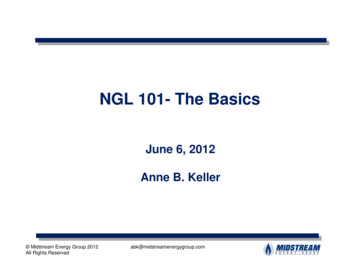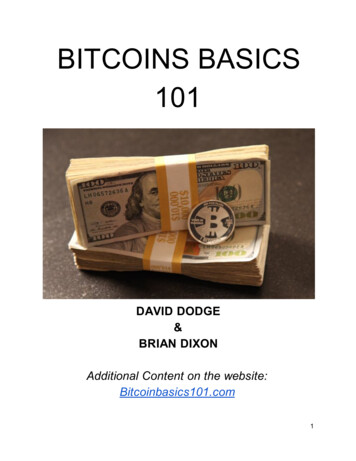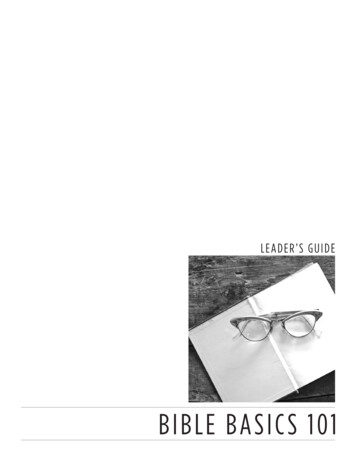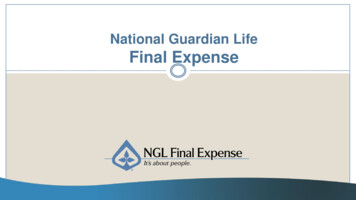
Transcription
NGL 101- The BasicsJune 6, 2012Anne B. Keller Midstream Energy Group 2012All Rights Reservedabk@midstreamenergygroup.com
GoalsTo understand What “NGL’s” areSize and characteristics of the NGL marketsMarket Fundamentals (USA): SupplyDemandLogistics costsPhysical basis calculations/impact on gas value
NGL Supply – U.S. OverviewAlmost 100% of theethane production inthe U.S. and Canada issourced from naturalgas processing plants60% of global NGL isproduced from naturalgas (U.S. is app. 75%)3EthaneRefineries.6 MillionBbl/dayGas Plants2.3 MillionBbl/dayPropaneNC4IC4C5
NGL Supply – NGL’s from Natural GasShale Gas BasinsNow account for 20 % of total U.S. gas production and potential 15 years of reserves4
Definitions – NGL’sWhat is NGL?NGL – Natural Gas LiquidTypically refers to ethane, propane, butanes,and natural “gasoline” (pentanes)NGL’s are hydrocarbons removed (condensed)as a liquid from a hydrocarbon stream that istypically in a vapor phase (i.e. natural gas)They are kept in a liquid state for storage,shipping and consumption
Difference between “NGL & LPG”Illustration: “Natural Gas Liquids - Supply Outlook 2008-2015”, International Energy Administration
Definitions - NGL Types“Purity Products”“Purity” means that most (at least 90%) of theliquid stream contains one type of moleculeEthanePropaneIso-butaneNormal butane
Definition of TermsEthaneSimplest molecule containingmore than 1 carbon atom (C2H6)Foundation of many compoundsin the petrochemical industryAbbreviated as “C2”Vaporizes at -126 F (-88 C)
Definition of TermsPropaneAbbreviation – C3Chemical composition C3H8 Boiling point -44 F (-42 C)
Definition of TermsNormal ButaneAbbreviation – NC4Chemical composition C4H10 Boiling point 32 F (0 C)
Definition of TermsIso-ButaneAbbreviation – IC4 Boiling point 11 F (-12 C)Also known as methylpropaneChemical composition Is an ‘isomer’ of normal butane – differentarrangement of the hydrogen molecules makes itbehave differently; weighs less than NC4“Isom” (Isomerization) units convert normal butaneto iso-butane when demand for IC4 is high
Definition of Terms“Mixed” Products“Mixed” means that the product stream contains atleast 2 different types of moleculesProducts sold as mixes: Ethane – propane mix (E/P)Natural gasoline (C5 )
Definition of TermsE/P MixA blend of ethane andpropane meeting theindividual specificationsfor each“Typical” blend quotedin market reports is80% ethane/20%propane Used only for ethyleneproduction Some chemicalcompanies requirecustom blendsPrice quoted as “ethanein E/P” for the 80%portion and the puritypropane price for the20% propane portion
Definition of TermsNatural GasolineAbbreviation – C5 (the “ ” means it’s amix of pentanes plusheavier moleculessuch as C6-C9 insmaller amounts)Usually fewmolecules heavierthan C10Markets Gasoline blendingEthylene productionSolvent production(specialty application)Ethanol (denaturant)Diluent for use insyncrude operations
NGL Market Characteristics
NGL Supply/Demand OverviewHow Big Is This Market?Global supply – NGL: 11.8 million BPD: 1.79 million BPD ethane 7.77 million BPD propaneand butanes (aka “LPG”) 2.23 million BPD gasplant condensate/C5 Sources Natural gas processing –60% Crude oil refining – 40%Relative to crude oil and refinedproducts, market size is small Global crude oil and gasliquids supply is 89-91 millionBPD NGL/LPG is 13% of thisNGL’s are getting more attentionnow: NGL’s are a growing source ofrevenue for gas producers NGL production in the U.S. is 1/3of our total crude and NGLsupply
NGL Markets OverviewUSANGL Supply SourcesGas Processing &Fractionation 74%2,249 M BPDCrude OilRefining 20%620 M BPDOverland &Waterborne Imports6%177M BPDNGLs Produced1NGL DemandEthane – 42%Propane – 28%Normal Butane – 8%Iso-Butane – 9%Natural Gasoline – 13%Ethane – 5%Propane – 53%Butanes – 10%NaturalGasoline2 – 32%Propane – 58%3Mixed Butanes – 14%Pentanes Plus – 28%1Percentof bbls from this source2Refinery naphtha exported to chemical plants3Canada exports app. 2/3 of its propane to the US12 Month Averages – March 2011 to Feb 2012Source: EIA, Waterborne LPG Report, Hodson Report, MEG AnalysisPetrochemicals54%1,619 M BPDMotor GasolineComponents 17%335 M BPDSpace Heating& Other Fuel Uses 19%567 M BPDExports 7%InventoryChanges 3%Ethane58%Propane23%Normal Butane5%Iso-Butane2%Natural Gasoline 12%Normal Butane 26%Iso-Butane37%Natural Gasoline 37%PropanePropane60%N-Butane11%Natural Gasoline 29%(diluent)
NGL’s from Natural GasImportance of Gas Supply Estimates to NGL ForecastersIn a low gas price environment, NGL value is a keycomponent of cash flow for gas producersNGL volume available for extraction depends on: Amount of gas available to processing plants How much NGL is contained in the gas that is producedNGL volume actually extracted depends on: Process technology employed for NGL extraction NGL prices at the plant, net of transportation to market Economics of recovering ethane Processing contract terms18
NGL’s from Natural GasForecasting Gas Supply When Gas Prices Are LowFactors affecting gas volume forecasts: The producer’s price hedge positionsImpact of slowing production rates on the total amountof gas that can be recovered“Take or pay” comments to service providers, such aspipelines, gas plants, NGL service companiesExpiration of lease agreements – keep drilling or losethe leaseDrilling contracts – keep drilling or lose the rigsNGL value impact on overall gas revenue – highervalues may support continued drilling19
NGL’s from Natural Gas“Dry Gas” Lower NGL Revenue, Lower ReturnsFees to move NGL’s to market can make a big difference inwellhead valueSource: Credit Suisse20 15% Rate of Return
Top NGL Producers in the U.S.Midstream Companies Are Primary Suppliers000Only 4 of these companies are also top gas producers; the others are midstream companiesSource: DCP Midstream21
NGL’s from Gas - Processing EconomicsGas Plant Profitability Metric – “Frac Spreads”The gas plant equivalent of a refinery “crackspread”Measure of gross profitability for gas plantsCalculated as the difference between therevenue from sales of NGL’s contained in a gasstream as liquid and their value if left in the gaspipeline and sold at gas prices22
NGL’s from Gas - Processing EconomicsNGL Yields – “Gallons Per Mcf”Wellhead Stream4% C5 6% NC43% IC4C3C2Need to know how much of the gas stream is NGL and what type NGL it is“Theoretical” NGL yield is 100% of what the sample shows is thereThe acronym for the “Gallons Per Mcf” of NGL’s in a gas stream is “GPM”23
NGL Composition TrendHigher Ethane Content per BarrelUS Composite NGL Barrel Composition by Component2009 AverageDec 2011 AverageNC4C3C4/C5 IC4C5 NC4C3C4/C5 IC4IC4C5 C5 C2C2EthanePropaneButane/C5 TotalNC4 768 M BPD547 M BPD595 M BPD1,910 M BPDEthanePropaneButane/C5 Total Dec 2011Total 2011 Avg. 1,005 M BPD669 M BPD677 M BPD2,351 M BPD2,181M BPDVolumes are rising – but C4 volume share of the NGL Barrel has fallen by 2%Source: EIA, MEG Analysis24
NGL’s from Gas - Processing EconomicsGas Quality – Example “GPM” for Various Basins25
NGL’s from Gas – Yield EstimatesImpact of Gas Plant TechnologyPlant technology determines the limit of the NGL’s that canactually be recovered from the gas:“Lean oil” plant NGL recoveries Least efficient for ethane, propane99% butanes and C5 , 65-75% propane, only 15-30% ethaneRefrigeration plants (use propane to “chill” the gas toremove more NGL) More efficient100% propane, butanes, and C5 , up to 80-85% ethaneCryogenic (turbo expander) technology Most efficient and most expensive to build100% propane, butanes and C5 , up to 85-90% ethane26
NGL/LPG RevenuesLogistics Costs MatterGas liquids are expensive to handle, store, andtransport compared to refined products Require high pressure and/or low temperature to maintainliquid state for shipment and handlingHighly flammable – vapor “crawls” instead of rising; isheavier than airNeeds special trucks, ships and storage (thick steel,insulated tanks, or underground caverns for largevolumes)
NGL Logistics – Realized Pricing Estimates“Netback” Market Concept & the “T &F” FeeNGL values basis different locations consist of the commoditycomponent and a location componentThe commodity component is the value for the product itself,but: NGL prices are only published at a few locations wherelarge volumes are traded (hubs) These traded prices must be adjusted by a locationdifferential to get the value at the plant tailgateRealized pricing at the plant Hub value - the Fractionationcost – Transportation CostThis is known as a “T&F” adjustment28
NGL LogisticsImpact of Location on Realized PricesEthane Recovery: Must consider the cost of getting to market when making ethanerecovery decisions: /MmbtuEthane Frac SpreadConway, KS Vs. Opal, WYJan 2010 – April 2012 Average Ethane Frac Spread:At Opal with estimated “T&F” included .59/MmbtuAt Conway w/o fee deducitons 2.50/Mmbtu29
NGL Logistics Costs“T&F” Cost Snapshot – Field to HubsBakken20-22 cpgRockies18-20 cpgMarcellusMidContinentSan JuanBasinW TXSE NM10-12 cpg28-30 cpgMontBelvieupgc117-South TXEstimated ranges for transportation & fractionation of mixed NGL’s – new build economics30
NGL’s from Gas - Processing EconomicsNGL Revenue Calculation – Plant IncomeNGLComponentVolumeActual YieldTransport Fee31At MarketLocationFractionationFeeComponentGross NGLRevenuePlant’s“Netback”NGL Revenue
NGL’s from Gas - Processing EconomicsNGL Revenue Calculation & Producer IncomePlant NGLNetbackRevenueProducerNGL RevenueShare32PlantProcessingFee(s)ProducerGas SalesProducerNGL RevenueShareProducerTotal GasStreamRevenue
Pipeline Expansions UnderwayAll Heading to Mont -basins.htmlNewly announcedSource: Oil & Gas Journal, May 7, 2012*In development/construction
Ethane MarketsEthane for Ethylene Production:% of Feedstock MarketTotal Ethylene Feedstock MarketTotal feedstock demand still 191M BPD less than 2004Ethane produces more ethylene with fewer pounds offeedstock
Ethane for Ethylene - OutlookExpansions under way willadd 60-80M BPD demand tothe Gulf Coast area by 2013New units planned for 2016-7could add 200M BPD moreBut meantime, supply growthis outpacing demandEthane demand increasing:Peak 950M BPD 2010Peak 1.015 million BPD Nov 2011Forecast 1.2 million BPD by 2015
/MmbtuEthane Frac Spreads /MmbtuCurrent Trends 2010-2012Prices & spreads peaked in Nov 2011; record demand Dec 2011Ethylene plant turnarounds began Jan 2012 – will prices move up when they’re over?Conway showing price pressure due to oversupply; can’t get the excess barrels south36
Ethane PricesHow Low Can They Go?Ethane – the alternate market is natural gas Price Forecast – start with the base price of gas at the planttailgate, plus cost to recover it as NGL, plus transportation andfractionation cost (T&F), plus a marginExample – assume gas price of 2.00/MMBTU Gas value is 13.18 CPG (BTU equivalent in CPG)Transportation and fractionation of 13.8 CPGPlant NGL extraction cost of 2.00 CPG (incremental expense)Would need a minimum of 34 CPG at the hub to justifyrecovery for this plant (13.18 13.8 2.00 5.00) toearn a 5 CPG margin as a return37
Propane Demand TrendsDemand Declining in Traditional MarketsM BPDLittle change in total US balance 2008-2011Refinery supply & imports are fallingApparent demand in traditional markets is decliningIncrease in gas plant supply is going to export & chemicals38
Propane Prices Reflect Supply ImbalanceSeeing price pressure:Propane Price as % of WTI
Propane – Heading Offshore AlreadyRising Inventories and Exports:Propane Exports Mont Belvieu000 BPDTerminal Capacity Booked through 2013Prices will settle at levels that encourage buying for winterSource: EIA
Supply/Demand – Normal ButaneTotal Gas Plant & Refinery 2009-2011Supply000 BPDDemand000 BPDGas plant supply of NC4 is flat in spite of increase in overall NGL volumes;possibly converting some to IC4, leaving some in C5 2011 net refinery balance is surplus of between 60 M BPD mixed butaneRefinery demand includes direct blending and refinery isomerization feedstockSwing market is ethylene feedstockSource: EIA, MEG Analysis41
Butane SupplyExceeding Domestic DemandAlso switching from imports to exports:Source: Waterborne LPG Report, April 26, 2012
000 BPDSupply/Demand – Iso Butane2009-2011Big increase in supply – up 17% Dec 2011 vs. Dec 2010Refinery demand meeting the challenge so farPropylene oxide production uses IC4 as wellSource: EIA, MEG Analysis43
Supply/Demand – C5 2009-2011Supply000 BPDDemand000 BPDGas plant supply up 10 % Dec 2011 vs. Dec 2010Imports rising – trans-shipments going to Canadian marketRefinery blending market is stableHigh crude prices and strong diluent market limit chemical demandSource: EIA, MEG Analysis44
NGL Markets – Butane/Pentane“Death Watch” for C4 and C5 Summer Blending?Key concerns for NGL markets will be proposed reductions inRVP and sulfur contentUltimate impact depends on: How much RVP is reduced and whereSulfur limitsChanges in product flows resulting from closure of East CoastrefineriesWhether WTI moves back toward parity with coastal crudes andpressures Mid-Continent refineries45
NGL Market ViewSummaryCurrent bottlenecks in the logistics systems will be resolved when newpipeline, fractionation, and terminal capacity is in operation – 18-24 monthsBasis spreads between regions will settle at levels closer to the cost of newcapacity but will stabilize at higher levels than in the pastPropane supply will seek export markets near term; on purpose propyleneproduction should help balance markets in 2-3 yearsLimited growth in motor gasoline demand, uncertainty around future fuelsregulations is driving assumptions that increased butane supply will have tobe moved offshore, or consumed in “on purpose” butadiene plants The surplus is likely to be mixed refinery butane – treating, storage, andexpanded logistics needed to handle this in the open marketDemand for C5 in ethylene cracking & gasoline blending not forecast toincrease Diluent market capability to handle increased volumes may depend on a crudeexport outlet other than the U.S.; prices already falling as supply grows inUpper Plains region
Contact InformationAnne B. KellerPresidentMidstream Energy Group, Inc.10707 Corporate Dr, Suite 158Stafford, TX egy consulting, project development, producer services,NGL marketing and logistics, training47
Crude oil refining – 40% Relative to crude oil and refined products, market size is small Global crude oil and gas liquids supply is 89-91 million BPD NGL/LPG is 13% of this NGL’s are getting more attention now: NGL’s are a growing source of revenue for gas producers NGL produc










